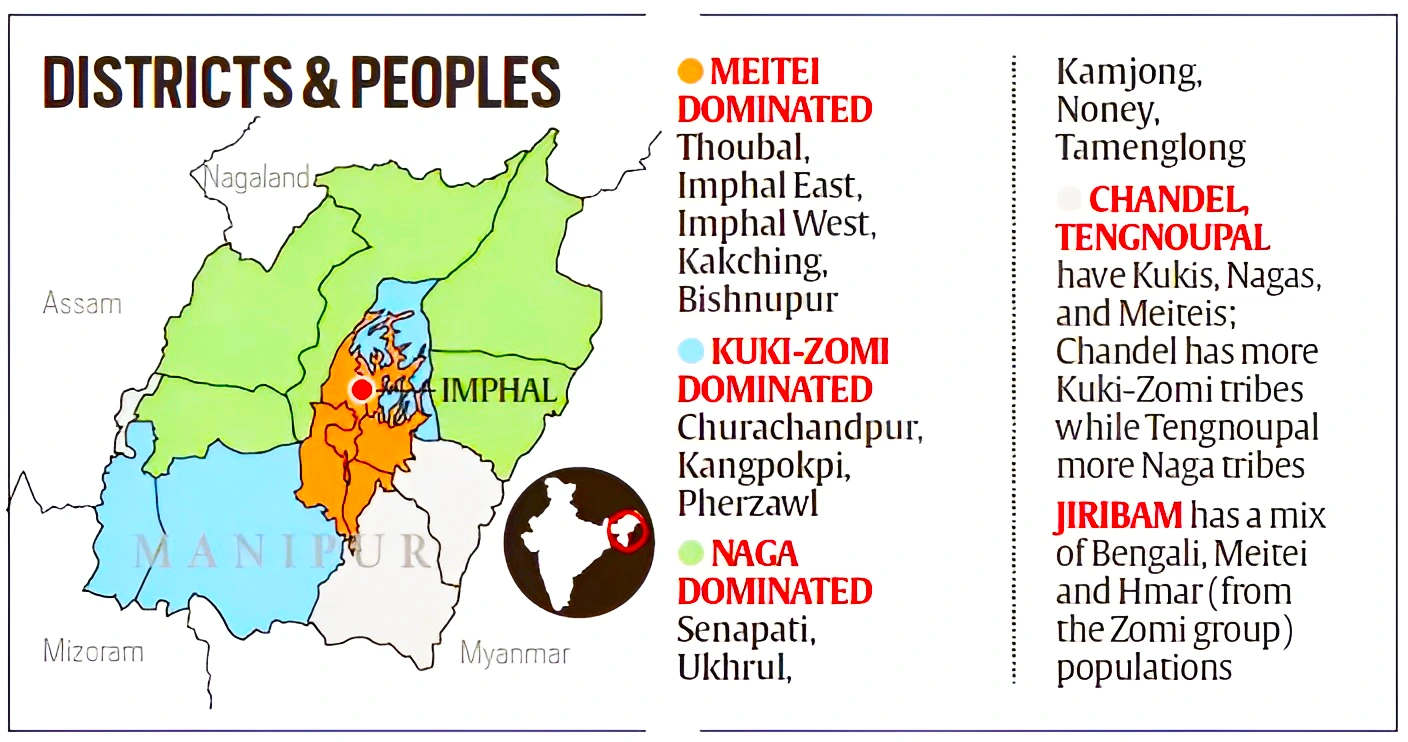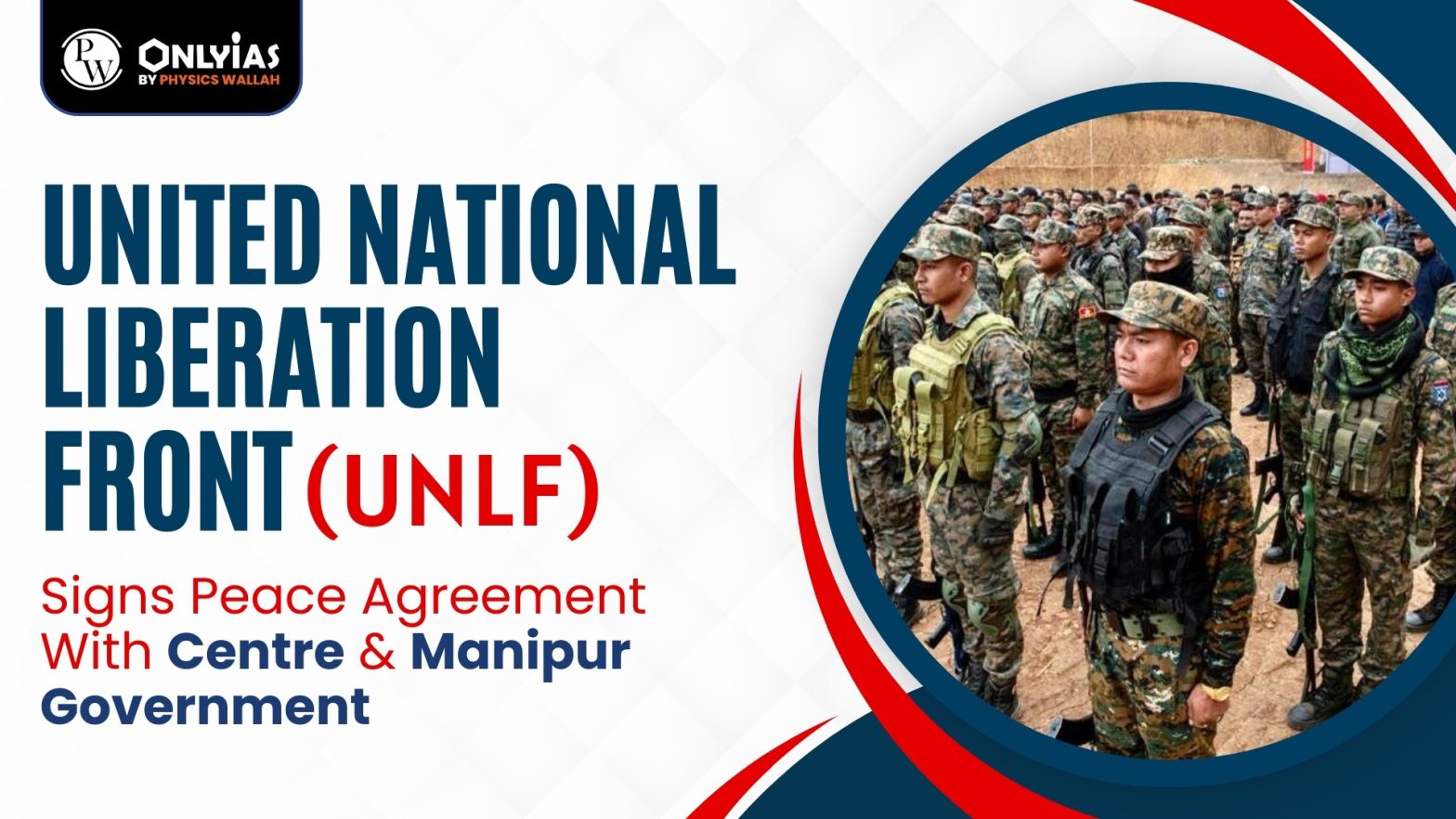Context: This article is based on the news “Manipur: UNLF faction says peace talks with govt a death trap, betrayal of people” which was published in the economic times” Recently, The Union and Manipur governments signed a peace agreement with the United National Liberation Front (UNLF).
| Relevancy for Prelims: United National Liberation Front (UNLF), Meitei Extremist Organizations, Manipuri Armed Groups, Manipur Peoples’ Army (MPA), Meitei, Kuki, Zomi, and Naga, Communities, Unlawful Activities (Prevention) Act 1967, Armed Forces Special Powers Act (AFSPA), and Bodoland Territorial Council.
Relevancy for Mains: Peace Agreement With United National Liberation Front (UNLF) in Manipur highlights the sustained efforts in conflict resolution, border management, and inclusive development. |
Peace Agreement With United National Liberation Front (UNLF)
- Ending hostilities and community concerns: The agreement will cease hostilities between the United National Liberation Front and security forces.
- Peace Monitoring Committee (PMC): It will be constituted to oversee the enforcement of the agreed ground rules.
- Factions joining agreement: The peace pact has been joined by around 65 cadres of one of the factions of the United National Liberation Front, led by K. Pambei.
- These 65 cadres of the Pambei faction entered Manipur during the ongoing ethnic violence.
- United National Liberation Front’s alternate faction led by Koireng operating from Myanmar with 300 Cadres stays outside the agreement.
- Historic transition: For the first time, a valley-based Manipuri armed group has agreed to return to the mainstream by abjuring violence and agreeing to honor the Constitution of India.
- Reduction in violence: The central government has signed peace agreements with several northeastern insurgents/rebels, enabling a decline of 73% in violent incidents, 72% in fatalities of security forces, and 86% in civilian killings during 2014-23.
Other Meitei Extremist Organizations:
- Peoples’ Liberation Army(PLA), and its political wing, the Revolutionary Peoples’ Front (RPF),
- United National Liberation Front (United National Liberation Front) and its armed wing, the Manipur Peoples’ Army (MPA)
- Peoples’ Revolutionary Party of Kangleipak (PREPAK) and its armed wing, the ‘Red Army’,
- Kangleipak Communist Party (KCP) and its armed wing, also called the ‘Red Army’,
- Kanglei Yaol Kanba Lup (KYKL),
- Coordination Committee (CorCom)
- Alliance for Socialist Unity Kangleipak (ASUK).
|
About United National Liberation Front:
- Genesis: The United National Liberation Front was formed in 1964 seeking Manipur’s secession from India and has been operating both within and outside Indian territory.
- Meitei extremist organizations: It is declared unlawful associations under the Unlawful Activities (Prevention) Act 1967.
What factors contributed to the rise of insurgency in Manipur?
- Demand for an Independent State: The militant organizations primarily based in the valley advocated for an independent Manipur.
- These included the United National Liberation Front, the People’s Revolutionary Party of Kangleipak (PREPAK), and the People’s Liberation Army (PLA), which received arms and training from China.
- These valley groups operated with a dual purpose of independence from India and warding off Naga insurgent groups.

| About NSCN:
The NSCN is a prominent insurgent group operating in the northeastern Indian state of Nagaland and some of the neighboring states.
Nagalim: The idea of Nagalim, as envisioned by the NSCN-IM, includes the Naga-inhabited areas of Manipur, Assam, Arunachal Pradesh, and Myanmar. |
- Spillover effect from Nagaland: The Naga movement from the nearby state of Nagaland extended into the hill districts of Manipur controlled by the NSCN-IMl(Isak-Muivah faction of the National Socialist Council of Nagaland or NSCN (I-M).
- They advocate for Greater Nagaland, a concept viewed in the valley as a potential “threat” to Manipur’s territorial integrity.
- Emergence of Kuki insurgent groups: The Kuki-Zomi groups rose in reaction to Naga aggression against the Kukis.
- Thousands of Kukis were rendered homeless after the massacre of Kukis by NSCN-IM in 1993.
Naga and Kuki Community:
- There are 34 recognized tribes, broadly classified as ‘Any Kuki Tribes’ and ‘Any Naga Tribes.
Geographical divide in Manipur:
- The state’s geography is divided between a central valley that accounts for about 10% of the landmass of Manipur and is primarily home to the Meitei and Meitei Pangals constituting roughly 64.6% of the state’s population.
- The remaining 90% of the geographical area comprises hills, surrounding the valley, that are home to the Naga and Kuki-Zo tribes which make up about 35.4% of the population.
The Kuki-Zomi insurgent groups:
- The Kuki-Zomi movement started as a defense against aggression by other groups.
- It later evolved into a call for Kukiland–an imagined country spreading across the Kuki-Zomi inhabited areas of India, Myanmar, and Bangladesh.
|
-
- Following this, the Kuki-Zomi tribes organized a number of armed factions.
- Around the same time, similar clashes took place between the Meiteis and Meitei Pangals (Muslims).
- Emergence of smaller Insurgent groups: The further continuance of insurgency led to the formation of smaller insurgent organizations like the Zeliangrong United Front (ZUF), People’s United Liberation Front (PULF), and other splinter groups.
What are the reasons behind the insurgency in Manipur?
- The Policy Polarisation: While the tribal Kuki-Zo and Naga communities can buy land in the valley, the Meiteis cannot buy land in the hills.
- The Kuki-Zo and Naga communities are entitled to reservation under the Scheduled Tribe classification but they feel under-represented in the Assembly of the Meitei-dominated government.
- Ethnic cleansing: The region has seen multiple inter-ethnic conflicts — Kuki-Naga, Meitei-Muslim, Kuki-Karbi, Hmar-Dimasa, and even Kuki-Tamil clashes.
- Meitei Hindus were converted to Hinduism by religious leaders from Sylhet in pre-partition Bengal leaving the community with a perpetual sense of identity crisis.
- Racial discrimination: Hate crimes against people from Northeast India in metros are treated as isolated incidents and they are neglected in policy discourse and are unacknowledged by the upper-caste Hindu majority of the country.
- Influx of refugees: The rise of Meitei nationalism and insurgency has been influenced by the influx of refugees from Myanmar.
- These refugees, sharing a common ethnicity with residents in the border areas of Manipur, often take refuge in the region.
- Efforts to curb poppy cultivation: Government actions, including crackdowns on poppy cultivation in the hill districts and addressing “illegal settlements” in these areas, are another factor behind the insurgency.
- Development deficit: On the Kuki-Zomi and Naga side, resentment is fueled by the significant underdevelopment of their districts, with a majority of the state’s budget allocated to the Imphal valley.
- Issues include the lack of infrastructure, such as roads, healthcare, and education, along with the perceived dominance of the Meiteis in the state’s administration, where they hold 40 MLAs compared to 20 tribal representatives.
- Poor Economic indicators: At Rs 84,345 in 2022, it has the lowest per capita income amongst the eight Northeastern states.
What are the impacts of insurgency?
- Provoking Anti-national sentiments: The valley groups, particularly the United National Liberation Front, have resorted to strikes on various occasions. Ex-August 15 or January 26.
- The Meitei groups have solidified the moral code of the valley with ‘laws’ that prohibit wearing Indian clothing, watching Hindi films listening to Hindi music, and watching Meitei films.
- Influencing Public Opinion: Candidates, irrespective of their political affiliations, run for elections with support from insurgent groups, and exert influence on electorate voting decisions.
- In the previous Assembly election, the KNO president instructed voters to support the BJP and significantly swayed the electorate in favor of the party.
- Deterioration of law and order: The deterioration of law and order in Manipur creates concerns of fringe elements becoming active.
- The region, with its porous international border with Myanmar, is known for the activity of smugglers, including those involved in drug transportation.
- Shelter to illegal refugees: The insurgents are accused of backing poppy cultivation and providing shelter and protection to Myanmarese refugees who entered the district Churachandpur fearing persecution in their home country by the military junta.
Government Response:
- Imposition of AFSPA: In 1980, the Centre declared Manipur a “disturbed area” and imposed the Armed Forces Special Powers Act (AFSPA) to suppress the insurgency movement.
Peace Agreements signed by the Central governments in North-East recently:
- Naga Peace Accord 2015: It was signed in August 2015 by the Government of India and the National Socialist Council of Nagaland (NSCN) to end the insurgency.
- Bodo Peace Accord: It was signed on 27 January 2020 with factions of the National Democratic Front of Bodoland (NDFB), All Bodo Students Union etc to increase the scope and power of the Bodoland Territorial Council, resolve issues related to Bodo people residing outside Bodoland Territorial Area Districts (BTAD).
- Karbi-Anglong Peace Agreement (2021): It was signed between the Centre, the Assam government and insurgency groups to bring peace to the Northeastern state’s Karbi-Anglong district.
|
- Suspension of Operation (SoO) agreement: Various peace talks led to a tripartite SoO agreement between the Centre, the state, and the Kuki-Zomi groups in 2008.
- The SoO agreement protects the insurgent groups from action by Indian or state security forces in exchange for a halt to the insurgency.
- Ceasefire agreement: It was agreed between the NSCN-IM and the Government of India (GoI) in 1997.
- Suspension of Operation (SoO) pact: It was signed by the Kuki outfits under two umbrella groups, the Kuki National Organisation (KNO) and United People’s Front (UPF) with the GoI and Manipur on August 22, 2008.
Way Forward:
- Preventing insurgent activities: The administration needs to be vigilant for possible trouble spots and try to avert any negative incident before it happens. Control over the drug trade requires special attention for this.
- Voluntary Surrender policy: Concerted and deliberate operations must be launched coupled with incentives for those who voluntarily surrender.
- Disarming locals in possession of illegal arms is to be done through coordinated actions by the security forces.
- For this, each organization’s roles and responsibilities must be clearly defined.
- Enroll and Invite the Youth for Talks: Multi-layered interaction with youth leaders and other selected youth is needed to ensure Manipur returns to normalcy faster.
- Unified Command structure: A vibrant, dynamic, and effective Unified Command structure is needed to bring Manipur out of the state of insurgency.
- Role of Civil Society Organisations: Civil society organizations, retired defense personnel, academicians, and intelligentsia will have to demonstrate a shared perspective and commitment to restoring normalcy in Manipur.
- Neither civil society organizations nor student bodies, which once held significant roles in Manipuri society, actively participate in the dialogue, hindering peace-building initiatives.
- Border management with Myanmar: It demands a holistic review, especially in the wake of illegal immigration and drug menace.
- Integrated development policy: The Strategy for the integrated development of the region as part of ‘Act East Policy’ entails the exploitation of its vast natural and human potential, besides accelerating the pace of road, rail, and marine connectivity with South East Asia.
- Kuki-Zomi’s concerns about underdevelopment and their questions about the fairness of the administration need to be addressed.
- It demands a consensus among the Meitei, Kuki, Zomi, Naga, and other leaders to build a consensus around a Manipuri identity.
Conclusion:
The recent peace agreement with United National Liberation Front (UNLF) in Manipur reflects a significant step towards resolving longstanding conflicts, emphasizing the need for continued efforts in inclusive development, border management, and sustained peace-building initiatives involving diverse communities in the region.


